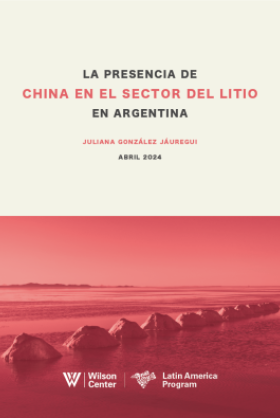Cement and Climate Change in China
Cement production is an energy-intensive process. It is estimated that China's cement—much of which is produced in energy inefficient, highly polluting kilns—consumes roughly six percent of the nation's energy.
Overview
China is the world's largest producer of cement. Its production has grown about 10 percent per year over the past two decades and is now growing even faster to keep up with massive urbanization. Today China produces roughly half of the total global output of cement, whereas the next three largest producers—India, Japan, and the United States—combined produce less than 20 percent. By nature, cement production is an energy-intensive process. It is estimated that China's cement—much of which is produced in energy inefficient, highly polluting kilns—consumes roughly six percent of the nation's energy, with 80 percent of that coming directly from coal and other fossil fuels and the remaining 20 percent from electricity, which is mainly derived from coal. Cement manufacturing is thus a major contributor to greenhouse gas (GHG) emissions in China.
To overcome the inherent challenges of cement manufacturing, the Chinese government has extensively developed government policies and programs to improve energy efficiency and pollution control in the cement sector. China has been proactively engaged in various international initiatives, such as the Asia-Pacific Partnership (APP) on Clean Development and Climate, which is helping China adopt advanced cement production technologies and efficient management skills. The World Resources Institute's (WRI's) GHG Protocol Initiative, which is the most widely used international accounting tool for government and business leaders to understand, quantify, and manage GHG emissions, is also active in working on the cement sector in China.
At this China Environment Forum meeting, Wang Lan from China's Building Materials Academy provided a short overview of the environmental impacts of China's cement sector and discussed some of the ongoing projects, retrofits, and policies that are reducing energy use and pollution, while still maximizing the industry's economic performance and output. Pankaj Bahtia discussed some of the collaborative projects and activities the GHG Initiative has launched with key Chinese organizations including the National Development and Reform Commission, Tsinghua University, the China Business Council for Sustainable Development, China Building Materials Academy, and the China Standards Certification Center. His presentation also covered major challenges and opportunities in efforts to assist China in its plans to manage and reduce energy use and GHG emissions in the cement and other industrial sectors in China.
China's Cement Sector
Wang Lan introduced the resource-intensive cement production processes (see PowerPoint in the See Also box to the right) in China, which consume 1.5 tons of raw materials, 120 kilograms of coal and 110 kilowatts of power. The cement industry in China emits on average 0.85 tons of GHGs (mainly CO2) and 0.02 tons of dust per ton produced. Cement is more extensively used in construction in China than in the United States due to different construction methods stemming from higher use of alternative building materials in the United States. In 2007, China produced about 1.4 billion tons of cement—amounting to almost one ton per capita—which emitted 0.95 billion tons of CO2. About 25 percent of all CO2 emissions in China can be attributed to cement production. (For more information, see the China Environmental Health Project research brief Environmental and Health Threats from Cement Production in China.)
Domestic Initiatives
To tackle the problem of the cement industry's high resource consumption and excessive pollution, the Chinese government has promulgated the Energy Conservation Law and Environmental Protection Law, which include measures to encourage industries to curb emissions and promote energy efficiency. In addition, cement is among the ten energy-intensive industries in which the Chinese government plans to initiate both energy-saving and emission reduction projects in the 11th Five Year Plan period. These projects include eliminating outdated production capacity and installing more advanced technologies and production lines. In China, newly developed highly energy efficient precalcining kilns with low NOx emissions are now widely used, and dust collectors and electrostatic precipitators (to eliminate particulates) are already operating in most Chinese cement plants. The cement sector is also experimenting with alternative fuels and raw materials (AFRs) with the goal of halving CO2 emissions. With low investment and operation cost, cement kilns can be used to safely process China's growing consumer waste, either as a fuel source or as a cement component. Increasing energy efficiency and reducing emissions have become the priority of Chinese cement factories, in part because of state mandate, but more importantly because of the potential profitability of these goals.
International Cooperation
In 2003—as China prepared to ratify the Stockholm Convention on persistent organic pollutants (POPs)—the Chinese State Environmental Protection Administration (now the Ministry of Environmental Protection/MEP) and the U.S. Environmental Protection Agency (EPA) began cooperating to reduce emissions of POPs, such as dioxins and furans, from cement kilns. The project has so far assessed 8 sampling sites chosen from the 7,000 cement factories in China. In a joint pilot study of the Luzhong Cement Plant, the U.S. EPA and MEP found that the installation of vertical shaft kilns reduced energy consumption by 5 percent. This plant will serve as a model project for the China's whole cement industry.
Other international cooperation includes work with the U.S. Business Council for Sustainable Development (USBCSD) on AFR and biofuels in the cement sector and the Asia Pacific Partnership Cement Task Force (APP CTF) on promoting clean development and reducing climate impacts of the cement sector.
GHG Protocol Initiative
WRI's GHG Protocol Initiative is one international project that aims to reduce the environmental impact of China's cement sector. Conceived 10 years ago, the GHG Protocol Initiative has been adopted by most developed countries and is at the incipient stage in developing countries, namely China, Brazil, and India. The GHG Protocol in China has four goals to: (1) design a national GHG standards; (2) set up and implement GHG Protocol training and capacity-building programs; (3) develop customized GHG calculation tools and software; and (4) establish GHG registries at the national, provincial, and/or industrial-level.
To serve the first goal of designing national GHG standards, WRI in collaboration with the World Business Council for Sustainable Development (WBCSD) and the China Business Council for Sustainable Development (CBCSD), launched the China Energy and GHG Management Program in June 2007. Thus far, the program has conducted pilot projects to establish national voluntary standards in the cement, oil, and gas sectors and it plans to expand into the iron, steel, power, and chemical sectors. For the second goal of designing and implementing GHGP training and capacity-building programs, WRI has developed partnerships with the National Development and Reform Commission, CBCSD, and the China Building Materials Academy (CBMA), and has completed the training of trainers from CBCSD, CBMA, Beijing Cement Company and Sinopec Economic Development Division on the value and methods of monitoring and reporting GHG emissions. To achieve the third goal of developing customized GHG calculation tools and software, WRI will develop energy and GHG accounting software, funded by the Energy Foundation, for use in conjunction with China's 1,000 Enterprises program. For the fourth goal of establishing GHG registries at the national, provincial, and/or industrial-level, WRI has been cooperating with China Standards Certification Center, and to date the two organizations have completed preparations for a GHG registry based on the GHG Protocol.
Future of the Cement Industry
Reflecting on his experience working on the cement sector in China, Pankaj Bhatia praised the enthusiasm and dedication of Chinese counterparts in working to reduce the environmental impact of the cement industry. The willingness of government and private actors to work with international partners in developing long-term solutions is already combating dangerous pollutants in many cement plants, despite the obstacle of maintaining high production while combating and preventing future threats to environmental health. Cleaning up the cement sector can be beneficial to both the international community as well as China, as it will ultimately meet international goals of reduced GHG emissions and achieve domestic goals of reducing harmful pollutants and promoting efficient resource use.
Drafted by Jing Chen.
Documents & Downloads
Speakers
Hosted By

China Environment Forum
Since 1997, the China Environment Forum's mission has been to forge US-China cooperation on energy, environment, and sustainable development challenges. We play a unique nonpartisan role in creating multi-stakeholder dialogues around these issues. Read more

Urban Sustainability Laboratory
Since 1991, the Urban Sustainability Laboratory has advanced solutions to urban challenges—such as poverty, exclusion, insecurity, and environmental degradation—by promoting evidence-based research to support sustainable, equitable and peaceful cities. Read more

Environmental Change and Security Program
The Environmental Change and Security Program (ECSP) explores the connections between environmental change, health, and population dynamics and their links to conflict, human insecurity, and foreign policy. Read more
Thank you for your interest in this event. Please send any feedback or questions to our Events staff.










